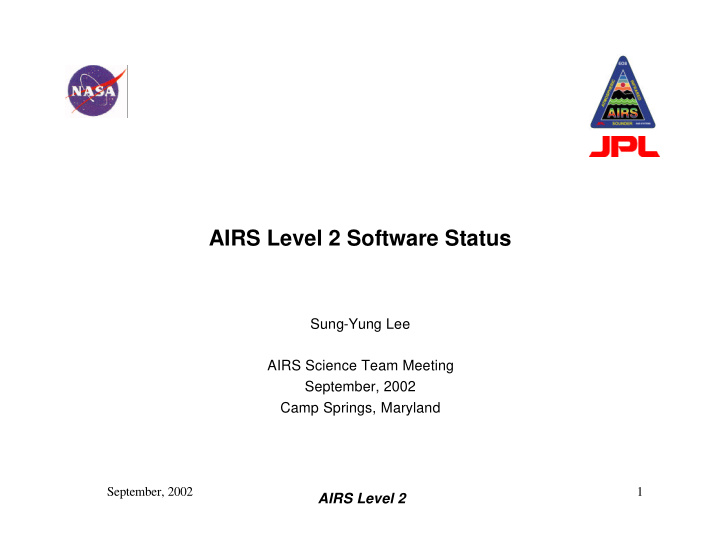



AIRS Level 2 Software Status Sung-Yung Lee AIRS Science Team Meeting September, 2002 Camp Springs, Maryland September, 2002 1 AIRS Level 2
Current Status of Level 2 PGE • Version 2.6.7 is the current version • Changes since May 2002 – Precipitation algorithm update – MW Tuning Tested • Ocean cases only • Tuning against NCEP forecast • Biases against ECMWF forecast from GSFC – 90+ % yield • Coastline, Precipitating area has lower yield – Final algorithm runs with real data • Non-optimal channel set, RTA, etc • Channel property file version v6.3.0 is current, but not final – 270 channels with nonzero BadFlag • Dead detectors • Noisy channels, NeDT > 2.0 • Bad spectral properties – Coordinate channel selection September, 2002 2 AIRS Level 2
Map of Retrieval Flags July 4, 2002, no tuning September, 2002 3 AIRS Level 2
Prototype • New CM Environment for level 2 developers – In addition to AR/CR/NR – Package name is of the form PT-xxxx-l2-?????-???? • Expedite Level 2 Development Cycle – Quick approval by Oliphant/Lee/Manning – Develop and Test – CCB approves after testing is complete • Level 2 developers should point to /ref/dev/ instead of /ref/devstable/ – Copies move to /ref/devstable/ only after CCB approval September, 2002 4 AIRS Level 2
Artifacts in AIRS radiances seen with real Data • Data Gaps • Saturated channels - few footprints a day – Mostly shortwave window channels, some longwave IR channels – Sun glinting, forest fire (Two cases so far, Siberia, Brazil) – Ignore the footprints • we can have up to 3 bad AIRS footprints within an AMSU footprint • Negative Radiance - Many and Often. Shortwave window channels during night at very low temperatures Over Antartica and high thick cloud – All algorithms are ready to handle negative radiances • Spikes, Popping, or sudden increase of noise – Pop detection algorithm is still under study – Channels that pop “often” will be added to the bad channel list – Some channels pop once in a long time with 3,000,000 spectra per day 5 sigma events will occur • Final algorithm can disregard the channel only when they pop • Regression algorithms can use the channel even when they pop – Stay tuned September, 2002 5 AIRS Level 2
Focus days • New version of PGS software will run on focus days – Measure progress of PGS software development – New Focus day when spectral property changes – The granules cover roughly the same area. • Focus1: July 4, 2002 – MW focus day – MW tuning is based on this focus day – MW only retrieval was run • Focus2: July 20, 2002 – Part of the period when AIRS was stable, July 19 - 28 • Focus3: September 6, 2002 – AIRS in operate mode since August 30, 2002 September, 2002 6 AIRS Level 2
Schedule 30th August AIRS put into “operate” mode 30th September RTA Coefficient to JPL, version 7 MW Tuning update 15th October Simulation for Focus day 3 (Sept 6) AIRS level 1b software V2.7 at JPL 30th November Preliminary level 2 at JPL Angle Correction Coefficients IR/MW Tuning Coefficients (GCM based) Regression coefficients (GCM based) Channel Selection for final algorithm 4th December RTA Coefficient to JPL, version 8 11th February Initial Build of v3.0 to JPL Delivery of all inputs from everybody 9th April Delivery of v3 to DAAC 8th May Start running level 2 PGE at GSFC-DAAC September, 2002 7 AIRS Level 2
Deliverables • September 30 – RTA Coefficient version 7 from Strow – MW Tuning update from McMillin • October 15 – Clear Simulation for IR/MW tuning from Fishbein • November 30 – IR/MW tuning from McMillin – Angle Correction Coefficients from McMillin – Regression coefficient from Goldberg – Channel Selection from Susskind (Final and BUFR) • December 4 – RTA Coefficient version 8 from Strow • February 11 – Final input for V3 from everybody September, 2002 8 AIRS Level 2
Recommend
More recommend